
Of all the counter-intuitive elements of quantum physics introduced to the public since its inception in the early days of the twentieth century, it is quite possible that the idea that a system can be two (or more) contradictory things at once, could be the most challenging.
As well as defying a well-known aspect of logic — the law of non-contradiction — thus irritating logisticians, this idea of the coexistence of states, or superposition, was even a challenge to the fathers of quantum physics. Chief amongst them Erwin Schrödinger, who suggested a diabolical thought experiment that would show what he believed to the ludicrous nature of a system existing in contradictory states.
The thought experiment would go on to become perhaps the most well-known in the history of physics, weaving its way on to witty t-shirts, hats, bags and badges, infiltrating pop-culture, TV and film. This is the strange tale of Schrödinger’s cat, and what it can teach us about quantum physics and the nature of reality itself.
Before delving into the experiment that Schrödinger devised, it is worth examining the circumstances that led him to consider the absurd situation of a cat that is both living and dead at the same time.
Wanted: Dead or Alive! How the cat got put in the box
In many ways, Erwin Schrödinger’s place in the history of quantum mechanics is overshadowed by his feline-based thought experiment. The Austrian physicist was responsible for laying the foundation of a theoretical understanding of quantum physics with the introduction of his eponymous wave equation in 1926. As Joy Manners describes in the book ‘Quantum Physics: An Introduction’:
“The Schrödinger equation did for quantum mechanics what Newton’s laws of motion had done for classical mechanics 250 years before.”
Joy Manners, Quantum Physics: An Introduction
What Schrödinger’s equation shows is that the state of a system — the collection of all of its measurable qualities — can be described as a wavefunction — represented by the Greek letter Psi (Ψ). This wavefunction contains all the information of a system that it is possible to hold. Each wavefunction is a solution to Schrödinger’s equation, but here’s the crazy part; two wavefunctions can be combined to form a third, and this resultant wavefunction can contain completely contradictory information.
When the wavefunctions of a system are combined it is in a ‘superposition’ state. There is also no limit no how many of these wavefunctions cam be combined to form a superposition.
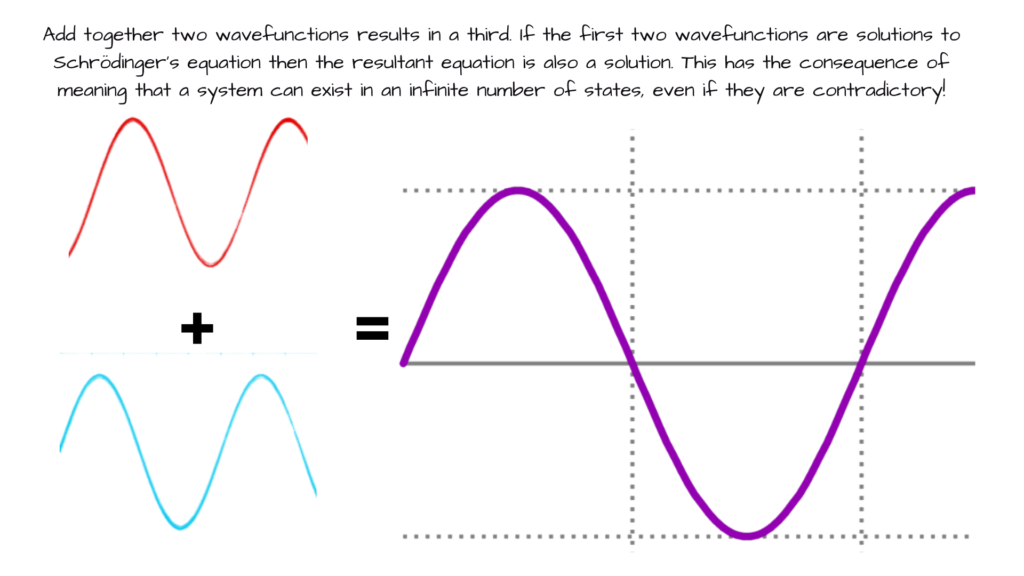
Yet, infinite though a wavefunction can be, eternal it is not. The act of taking a measurement on the system in question seems to cause the wavefunction to collapse — something there is as yet no physical or mathematical description for. There are, however, interpretations of what happens, which go to the very heart of reality.
Before tackling these interpretations, first, we should get to our cat in the box before he gets too impatient.
A most diabolical device
It was in 1935, whilst living in Oxford fleeing the rise of the Nazis, that Schrödinger first published an article that expressed his concern with the idea of measurement, wave function collapse, and contradictory states in quantum mechanics. Little would he know, it would lead to him becoming history’s most infamous theoretical-cat-assassin.
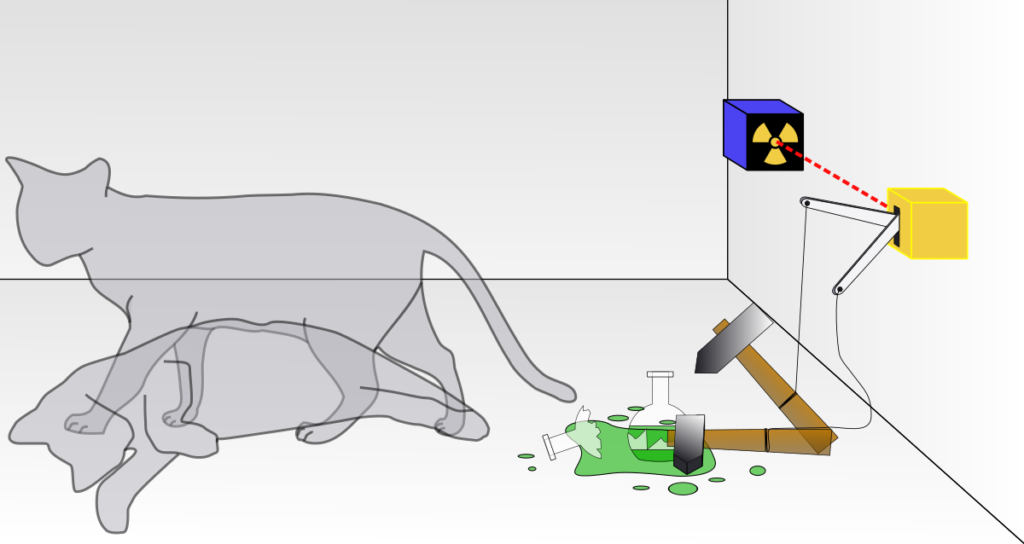
Below Schrödinger describes the terrible predicament that his unfortunate moggy finds himself in.
“A cat is placed in a steel chamber with the following hellish contraption… In a Gieger counter a tiny amount of a radioactive substance, so that maybe within an hour one of the atoms decays, but equally probable is that no atom decays…”
So, there is a 1/2 chance that an atom of the substances decays and causes the Gieger to tick over the hour duration of the experiment.
“If one decays the counter triggers a little hammer which breaks a container of cyanide.”
So, if the atom decays over the hour, the cat is killed. If it doesn’t, the cat survives. Treating the box and the cat as a quantum system how would we describe its wavefunction (Ψ)?
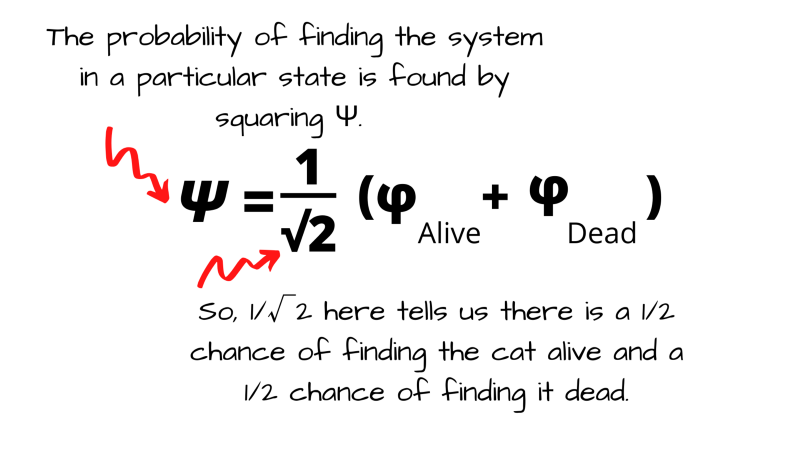
The wavefunction of the system now exists in a superposition of the individual wavefunction that describes the cat as being alive, and the one that declares it dead. According to the rules of quantum physics, the cat is currently both dead and alive.

Our unfortunate feline isn’t doomed to live out its existence as some bizarre quantum zombie, though. A quick peek inside the box constitutes a measurement of the system. Thus, by opening the box we collapse the wavefunction and determine the fate of Schrödinger’s cat. It really is curiosity that kills the cat, in this case.
Let’s end our analogy on a happy note. We open our box and fortunately the substance has not undergone decay. The cyanide bottle remains intact. Our moggy survives, unscathed if irritated. The wavefunction collapsed leaving the blue sub-wavefunction intact, but what actually just happened here? How was the cat’s fate determined?
The short answer is, we don’t know, but we have some interpretations. Next, we compare the two most prominent.
Way more than nine lives. The many-worlds interpretation
What we have discussed thus far consists of a very rough description of the Copenhagen interpretation of quantum mechanics. The reason it’s common sense to present this first is that it is generally the interpretation that is most widely accepted and taught.
As you’ve seen, the Copenhagen interpretation describes a system with no established values until a measurement occurs or is taken and a value — in our case ‘alive’ — emerges. If this sounds deeply unsatisfactory, well, it is. One of the questions it leaves open is ‘why does the wavefunction collapse?’
In 1957, an American physicist Hugh Everett III, asked a different question: ‘What if the wavefunction doesn’t collapse at all? What if it grows?’ From this emerged Everett’s ‘relative state formulation’, better known to fans of science fiction, comic books and fantasy as the ‘Many Worlds Hypothesis/interpretation’.
Below we see what happens to the wavefunction in the Copenhagen interpretation. The box is opened and the wavefunction collapses.
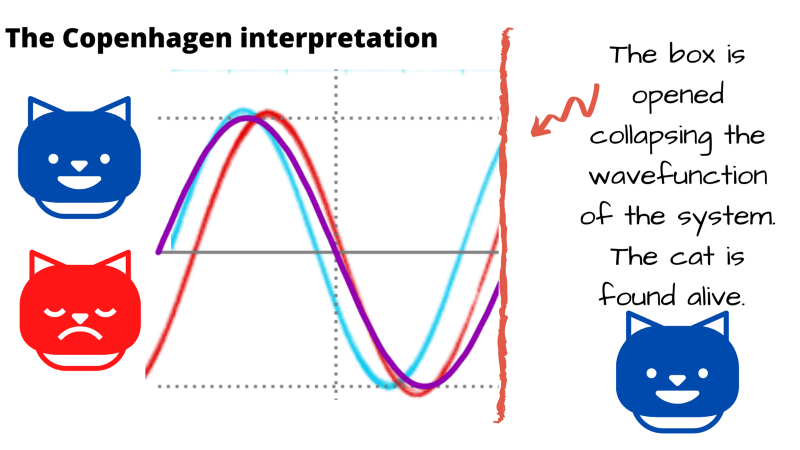
So what happens in the ‘many worlds’ interpretation? Rather than collapsing, as the box is opened the wavefunction expands. The cat does not cease to be in a superposition, but that superposition now includes the researchers and the very universe they inhabit. We become part of the system.
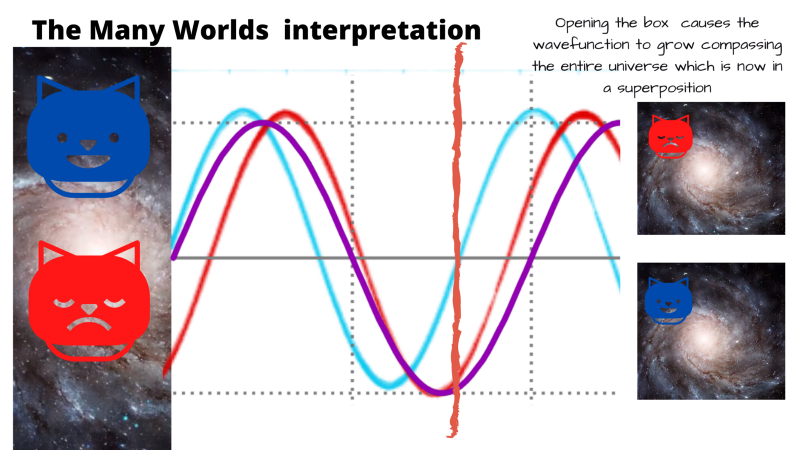
In the many-worlds interpretation, the researchers do not open the box to discover if the cat is dead or alive, they open the box to see if they are in the universe where the cat survived or the universe in which it was dispatched. They and their world have become part of the wavefunction. An entirely new universe in superposition with the old. The only difference.
One less cat.
Schrodinger’s Kittens: Some words of caution
Again, as with the Copenhagen interpretation, there is no real experimental evidence of many worlds concept. In many ways, any interpretation of quantum mechanics is really more a realm of philosophy than science. Also, when considering ‘many worlds’ it’s worth noting that this is a different concept than the idea of a ‘multiverse’ of different universes created at the beginning of time.
Further to this, there are some real problems with considering the ‘cat in a box’ as a quantum system. Researchers are constantly finding quantum effects in larger and larger systems, the current record seems to be 2,000 atoms placed in a superposition. To put that into perspective; a humble cat treat contains around 10²² atoms!
Many physicists have suggested reasons why larger systems fail to display quantum effects, with Roger Penrose suggesting that any system that has enough mass to affect space-time via Einstein’s theory of general relativity can’t be isolated. Via the influence of gravity, it is constantly having ‘measurements’ taken. This would definitely apply to even the most minuscule moggy.
It is worth noting here that the general description of the thought experiment and the opening of the box has led some to speculate that it is the addition of a ‘consciousness’ that actually causes the wavefunction collapse.
This is an idea that has sold a million or so books on ‘quantum woo’ and it arises from the unfortunate nomenclature of quantum physics. The use of the words ‘measure’ and ‘observe’ imply the intervention of a conscious observer. The truth is that any interaction with another system is enough to collapse a quantum wavefunction, as they tend to exist in incredibly delicate, easily disturbed states.
Sources and further reading
Schrödinger. E,
Griffiths. D. J, ‘Introduction to Quantum Mechanics,’ [2017], Cambridge University Press.
Broadhurst. D, Capper. D, Dubin. D, et al, ‘Quantum Physics: An Introduction,’ [2008], Open University Press.
Nomura. Y, Poirer. B, Terning. J, ‘Quantum Physics, Mini Black Holes, and the Multiverse,’
Orzel. C, ‘How to Teach Quantum Physics to your Dog,’ [2009], Simon & Schuster.